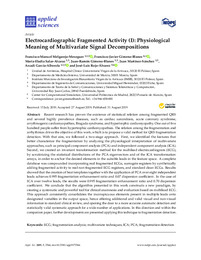Título :
Electrocardiographic Fragmented Activity (I): Physiological
Meaning of Multivariate Signal Decompositions |
Autor :
Melgarejo Meseguer, Francisco Manuel 
Gimeno Blanes, Francisco Javier
Salar Alcaraz, Mariela 
Gimeno Blanes, Juan 
Martínez-Sánchez, Juan
García-Alberola, Arcadi 
Rojo-Álvarez, José Luis  |
Editor :
MDPI |
Departamento:
Departamentos de la UMH::Ingeniería de Comunicaciones |
Fecha de publicación:
2019-08 |
URI :
https://hdl.handle.net/11000/30603 |
Resumen :
Recent research has proven the existence of statistical relation among fragmented QRS
and several highly prevalence diseases, such as cardiac sarcoidosis, acute coronary syndrome,
arrythmogenic cardiomyopathies, Brugada syndrome, and hypertrophic cardiomyopathy. One out of five
hundred people suffer from hypertrophic cardiomyopathies. The relation among the fragmentation and
arrhythmias drives the objective of this work, which is to propose a valid method for QRS fragmentation
detection. With that aim, we followed a two-stage approach. First, we identified the features that
better characterize the fragmentation by analyzing the physiological interpretation of multivariate
approaches, such as principal component analysis (PCA) and independent component analysis (ICA).
Second, we created an invariant transformation method for the multilead electrocardiogram (ECG),
by scrutinizing the statistical distributions of the PCA eigenvectors and of the ICA transformation
arrays, in order to anchor the desired elements in the suitable leads in the feature space. A complete
database was compounded incorporating real fragmented ECGs, surrogate registers by synthetically
adding fragmented activity to real non-fragmented ECG registers, and standard clean ECGs. Results
showed that the creation of beat templates together with the application of PCA over eight independent
leads achieves 0.995 fragmentation enhancement ratio and 0.07 dispersion coefficient. In the case of
ICA over twelve leads, the results were 0.995 fragmentation enhancement ratio and 0.70 dispersion
coefficient. We conclude that the algorithm presented in this work constructs a new paradigm, by
creating a systematic and powerful tool for clinical anamnesis and evaluation based on multilead ECG.
This approach consistently consolidates the inconspicuous elements present in multiple leads onto
designated variables in the output space, hence offering additional and valid visual and non-visual
information to standard clinical review, and opening the door to a more accurate automatic detection and
statistically valid systematic approach for a wide number of applications. In this direction and within the
companion paper, further developments are presented applying this technique to fragmentation detection
|
Palabras clave/Materias:
ECG
fragmentation analysis
multivariate techniques
ICA
PCA
fragmentation detection |
Área de conocimiento :
CDU: Ciencias aplicadas: Ingeniería. Tecnología |
Tipo de documento :
info:eu-repo/semantics/article |
Derechos de acceso:
info:eu-repo/semantics/openAccess
Attribution-NonCommercial-NoDerivatives 4.0 Internacional |
DOI :
https://doi.org/10.3390/app9173566 |
Publicado en:
Applied Sciences Applied Sciences Volume 9 Issue 17 (2019) |
Aparece en las colecciones:
Artículos Ingeniería Comunicaciones
|

 La licencia se describe como: Atribución-NonComercial-NoDerivada 4.0 Internacional.
La licencia se describe como: Atribución-NonComercial-NoDerivada 4.0 Internacional.
.png)